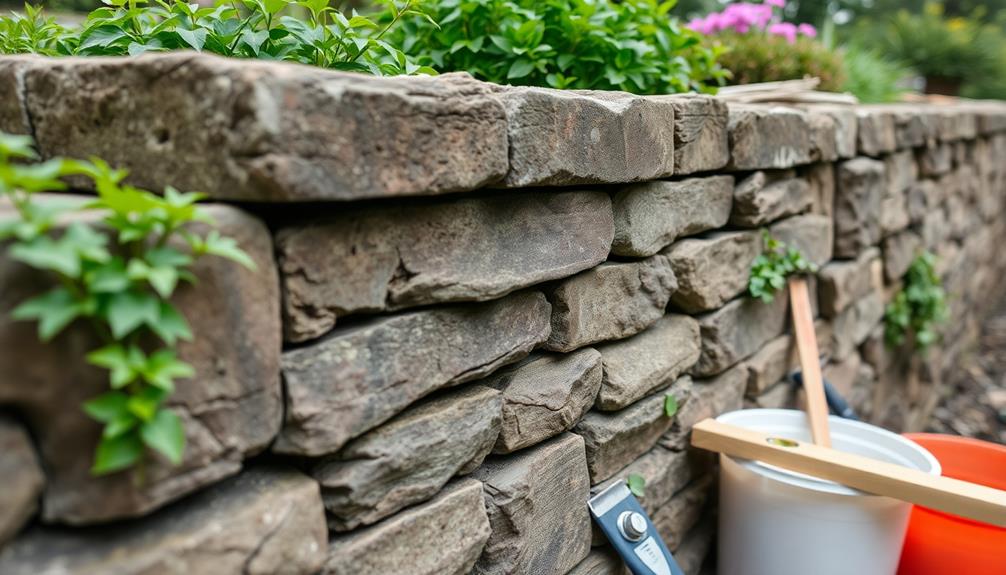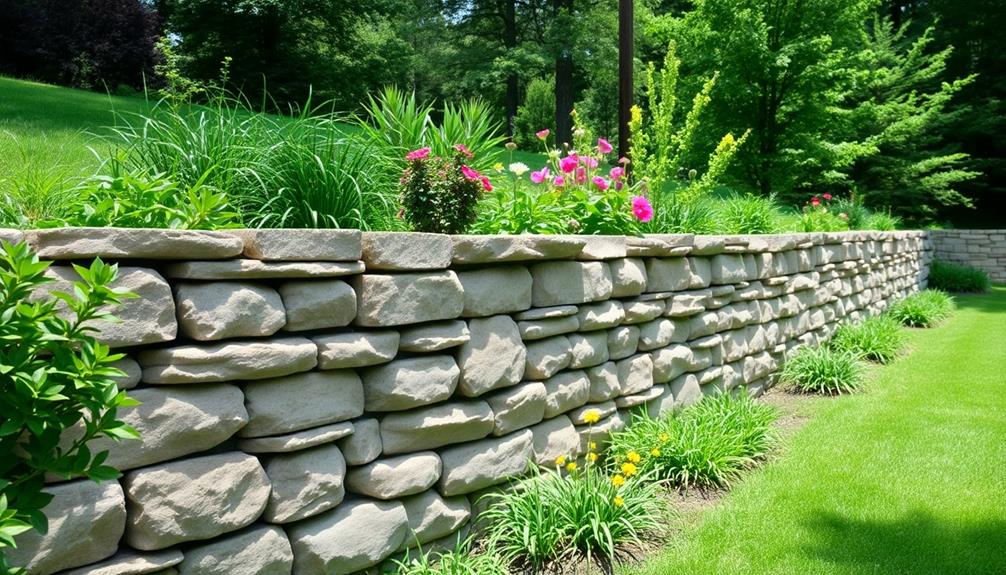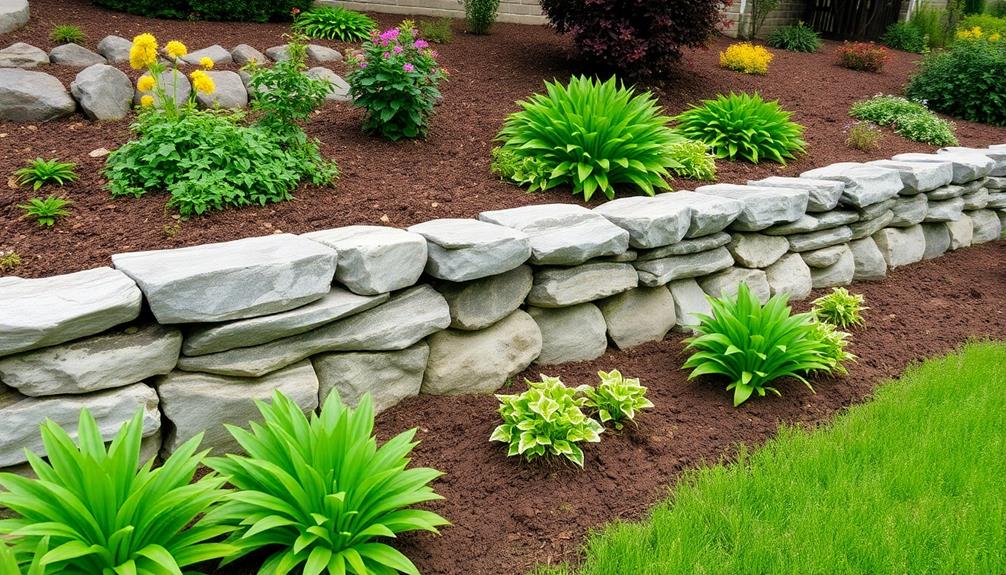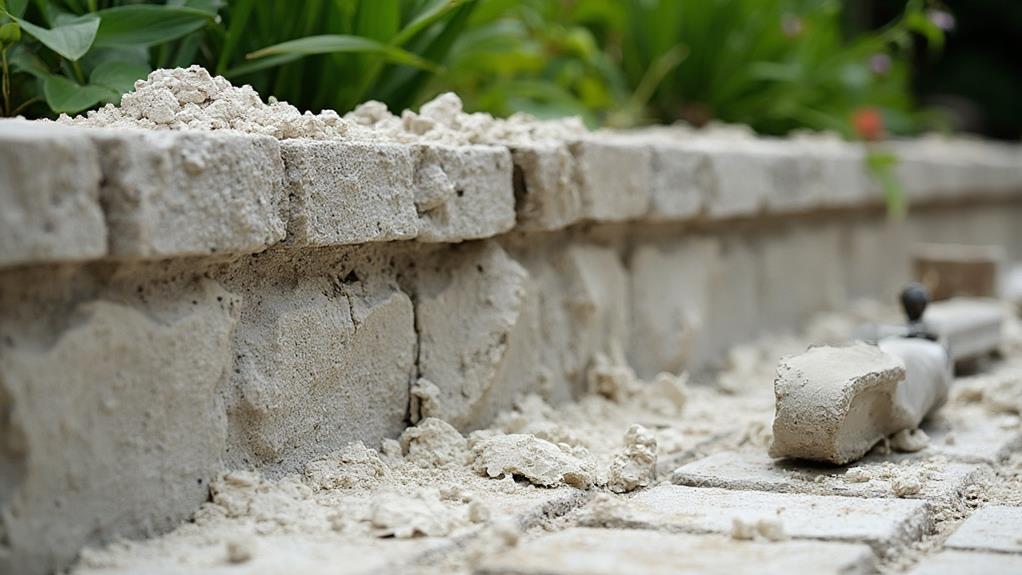Repairing retaining walls effectively begins with a thorough examination for structural issues such as cracks, bulging, and water seepage, which indicate soil movement or drainage inadequacies. Repair techniques should address these challenges through steel or geogrid reinforcement or underpinning for foundational stability. Incorporating effective drainage systems is essential to prevent hydrostatic pressure that causes damage. Material selection is key; concrete blocks offer robustness, natural stone provides strength and aesthetic appeal, while treated timber serves as a sustainable option. Each choice must align with the existing structure's needs and environmental conditions. Understanding these methods guarantees improved stability and longevity.
Table of Contents
ToggleWalls Contractor Highlights
- Examine the wall for cracks, bulges, and water seepage to identify structural issues.
- Address underlying soil movement or drainage problems to ensure long-term repair effectiveness.
- Use reinforcement materials like steel or geogrid to stabilize bulging walls.
- Select compatible materials such as concrete blocks, natural stone, or treated timber for durability.
- Incorporate proper drainage solutions to alleviate hydrostatic pressure and prevent water-related damage.
Defining Retaining Wall Repair

Repairing a retaining wall begins with the pivotal step of identifying structural issues, which involves a thorough examination of the wall's integrity and any signs of deterioration or instability. Often, walls made from materials such as boulder retaining walls are both durable and require specialized expertise, affecting repair decisions.
Once the underlying problems are established, evaluating repair techniques becomes essential, requiring a careful assessment of various methods to restore the wall's functionality and safety effectively. Selecting durable materials is the final component, ensuring that the repaired wall not only withstands environmental stresses but also maintains its structural integrity over time.
Identifying Structural Issues
When maintaining the integrity of a retaining wall, identifying structural issues is a vital first step in the repair process. Recognizing these issues early guarantees the longevity of the structure and the safety of the surrounding environment. The most common problems include cracks, bulges, and water seepage, each signaling potential weaknesses. Cracks may suggest movement in the wall, often caused by shifting soil or inadequate drainage.
Bulging areas are indicative of pressure imbalances, possibly due to water accumulation behind the wall, which can compromise its stability. Water seepage, another frequent issue, indicates inadequate drainage systems or material wear, which can erode foundational elements over time. Regular inspections are indispensable, as they allow property owners to detect these issues promptly, reducing the risk of more severe damage.
Engaging with professionals in the field ensures detailed evaluations, employing specialized tools and techniques to assess the wall's condition accurately. By fostering a proactive approach, communities can work together to maintain safe and aesthetically pleasing environments.
Ultimately, a thorough understanding of potential structural issues empowers individuals to make informed decisions regarding necessary interventions, reinforcing a collective sense of responsibility and care for shared spaces.
Assessing Repair Techniques
A thorough assessment of repair techniques is essential for effectively addressing retaining wall deficiencies. When evaluating repair strategies, it is indispensable to consider the wall's specific structural challenges, the surrounding environment, and the intended longevity of the repair. This extensive evaluation ensures that the chosen method aligns with the wall's unique characteristics and the expectations of those who rely on its stability.
A methodical approach involves not just recognizing visible damages but also understanding underlying issues such as soil movement or water drainage problems that may compromise the wall's integrity over time.
In the context of retaining wall repair, various techniques may be contemplated, each suited to different conditions. For instance, reinforcement with steel or geogrid materials may be appropriate for walls experiencing bulging due to lateral pressure. Alternatively, underpinning might be necessary to stabilize a wall suffering from foundational weaknesses. Additionally, the incorporation of drainage solutions can alleviate hydrostatic pressure, a common cause of wall failure.
Selecting Durable Materials
Selecting durable materials is fundamental in defining the success of retaining wall repair. The longevity and effectiveness of a retaining wall largely depend on the quality of materials used during the repair process. High-grade materials not only enhance structural integrity but also reinforce the wall's resistance to environmental stressors such as erosion, freeze-thaw cycles, and moisture infiltration. It's vital to evaluate materials like concrete blocks, natural stone, or treated timber, each offering unique benefits tailored to specific site conditions and aesthetic preferences.
Concrete blocks are favored for their robustness and versatility, enabling precise construction and efficient load distribution. Natural stone, with its timeless appeal and strength, offers an aesthetically pleasing solution that seamlessly integrates with the surrounding landscape. Treated timber, on the other hand, provides a cost-effective and sustainable alternative, particularly suitable for residential applications where visual warmth is desired.
When selecting materials, it's paramount to assess the compatibility with existing structures, soil types, and drainage requirements. Engaging with experienced suppliers and contractors who understand the nuances of material performance can foster a sense of community and trust, ensuring that the repair process not only meets but exceeds expectations.
Benefits

Repairing retaining walls offers several significant advantages, including enhanced structural integrity that guarantees the durability and safety of the property.
When it comes to eroding landscapes, retaining walls play a crucial role in preventing erosion, safeguarding your garden, patio, or parking spaces. Additionally, a well-maintained wall can lead to an increase in property value, making it a financially prudent decision for homeowners.
Moreover, implementing erosion prevention measures not only protects the landscape but also improves the overall aesthetic appeal of the area.
Enhanced Structural Integrity
Enhanced structural integrity is a paramount benefit of repairing retaining walls, as it guarantees the longevity and reliability of the structures. Ensuring that these walls are structurally sound provides peace of mind and fosters a sense of community among property owners who share a vested interest in maintaining the safety and durability of their surroundings. The process of reinforcing these walls involves meticulous attention to detail, which boosts their ability to withstand external pressures and environmental challenges.
When retaining walls are effectively repaired, the following benefits are realized:
- Increased Load-Bearing Capacity: Repairs often involve reinforcing the wall's foundation and structure, enabling it to support greater loads, thereby reducing the risk of wall failure.
- Improved Soil Stabilization: By addressing issues such as cracks or erosion, repairs enhance the wall's ability to hold back soil, preventing landslides or soil displacement that can affect nearby properties.
- Resistance to Weathering: Utilizing advanced materials and techniques during repair can considerably increase the wall's resistance to weather-induced wear and tear, extending its functional lifespan.
Increased Property Value
How does repairing retaining walls contribute to increased property value? A well-maintained retaining wall serves not only as a structural necessity but also as an aesthetic enhancement that can greatly boost property value. When retaining walls are repaired and maintained, they present a polished and cohesive appearance, which appeals to potential buyers who value both functionality and visual appeal. A property with robust and visually appealing retaining walls often stands out in the real estate market, highlighting the owner's commitment to upkeep and detail.
Moreover, a properly repaired retaining wall guarantees the longevity and durability of the landscape, which directly impacts the perception of the property's overall condition. Prospective buyers are more likely to invest in a home that requires minimal immediate repairs, understanding that a well-maintained property implies fewer future expenses and a reduced risk of structural issues. This sense of security can vastly enhance the property's marketability.
Additionally, retaining walls can be intricately designed to blend seamlessly with the property's architecture, creating a harmonious outdoor environment that complements the home. Such aesthetically pleasing enhancements can elevate the property's appeal, potentially increasing its value through enhanced curb appeal and functionality.
Erosion Prevention Measures
Erosion prevention measures, particularly when applied to retaining walls, offer substantial benefits by safeguarding the landscape and maintaining structural integrity. Implementing these measures guarantees the longevity of the walls, preventing costly repairs and fostering a sense of security within the community. The primary advantages of erosion prevention include environmental protection, enhanced durability, and the fostering of a cohesive neighborhood aesthetic.
By implementing strategic erosion control techniques, such as vegetation planting, geotextiles, and proper drainage systems, retaining walls can drastically reduce soil loss. This not only preserves the surrounding ecosystems but also enhances water quality by minimizing sediment runoff.
Erosion control fortifies retaining walls against the relentless forces of nature, such as heavy rainfall and wind erosion. This increased resilience guarantees that the walls maintain their structural integrity over time, reducing the likelihood of collapse and the ensuing disruption it may cause to a community.
A well-maintained retaining wall through effective erosion prevention measures contributes to a neighborhood's overall strength and resilience. This communal benefit fosters a sense of belonging among residents, as shared efforts to preserve the landscape create a unified and harmonious living environment.
Improved Aesthetic Appeal
Beyond the practical advantages of erosion prevention, the visual enhancement of retaining walls plays a substantial role in landscape aesthetics. A well-maintained retaining wall not only serves its fundamental purpose but also elevates the overall appearance of a property, creating a harmonious blend of functionality and beauty.
In a community where belonging is valued, the aesthetic appeal of retaining walls can significantly contribute to a unified neighborhood look, fostering a sense of pride and cohesion among residents.
Repairing retaining walls with an eye towards aesthetics involves selecting materials and finishes that complement the surrounding environment. Options such as natural stone, textured concrete, or decorative brick can transform a simple barrier into a statement piece, enhancing curb appeal and potentially increasing property value.
Additionally, incorporating elements like planters or integrated lighting can further enhance the visual impact, creating inviting spaces that resonate with the community's identity.
Professionally executed repairs guarantee the wall's longevity while maintaining its visual allure. By addressing structural issues promptly and creatively, homeowners can preserve the wall's integrity and appearance, ensuring that it remains a crucial and attractive part of the landscape for years to come. Such attention to detail underscores the commitment to preserving community aesthetics.
Soil Erosion Prevention Tips

Addressing soil erosion is crucial in maintaining the integrity of retaining walls, as it considerably contributes to structural stability and longevity. Implementing vegetation for stability, proper drainage solutions, and reinforcement techniques can effectively mitigate erosion risks. The table below outlines key aspects of these prevention strategies, offering insight into their practical application.
| Prevention Strategy | Key Benefit |
|---|---|
| Vegetation for Stability | Enhances soil cohesion |
| Proper Drainage Solutions | Reduces water accumulation |
| Reinforcement Techniques | Increases structural support |
| Soil Quality Management | Promotes healthy plant growth |
| Regular Maintenance | Guarantees long-term effectiveness |
Vegetation for Stability
When considering the long-term stability of retaining walls, incorporating vegetation is a critical strategy for preventing soil erosion. By selecting the right plants and placing them strategically, you can enhance the structural integrity of retaining walls while fostering a sense of unity with the surrounding landscape. Vegetation serves as a natural barrier against erosion, binding the soil with their root systems and reducing runoff.
Select Appropriate Species: Opt for native plants that are well-adapted to the local climate and soil conditions. Native species not only thrive with minimal maintenance but also support local biodiversity, creating a harmonious environment.
Consider Root Structure: Choose plants with fibrous root systems, as they are particularly effective in holding soil in place. Such plants create a dense network of roots that intertwine with the soil, reinforcing the wall's stability.
Strategic Planting: Position plants at various heights on the wall, ensuring even coverage. This method helps in maximizing the soil's retention and reduces the impact of water flow during heavy rains.
Proper Drainage Solutions
In addition to the stabilizing benefits of vegetation, implementing proper drainage solutions is fundamental for the longevity of retaining walls. Drainage systems play a critical role in mitigating hydrostatic pressure, which is the force exerted by water accumulating behind the wall. This pressure, if left unmanaged, can lead to wall failure, emphasizing the need for effective water management strategies. A well-designed drainage system not only preserves the structural integrity of the wall but also fosters a sense of security and belonging within the community it supports.
To achieve ideal drainage, incorporating gravel backfill and perforated drainage pipes can prove invaluable. These elements facilitate the efficient movement of water away from the wall, preventing the saturation of soil and subsequent erosion. Additionally, ensuring that surface water is directed away through properly graded slopes and strategically placed weep holes enhances the efficacy of the system.
Regular maintenance of drainage components is essential, as blockages can compromise their functionality. By adopting these proactive measures, communities can feel assured that their retaining walls will withstand the test of time, safeguarding both property and the environment. Consequently, engaging in such preventative practices fosters communal resilience and harmony.
Reinforcement Techniques
While retaining walls are instrumental in preventing soil erosion, reinforcement techniques are essential for enhancing their durability and effectiveness. The application of these techniques not only fortifies the structural integrity of retaining walls but also empowers communities to maintain landscapes that resist the forces of nature.
To guarantee comprehensive reinforcement, consider the following key strategies:
- Geogrid Installation: This synthetic material is placed between layers of soil to provide additional stability and strength. Geogrids help distribute weight evenly and prevent soil displacement, which is vital for maintaining the wall's structural health.
- Soil Nailing: An effective method for reinforcing soil, this technique involves inserting steel bars into pre-drilled holes in the slope. The nails are then grouted in place, creating a composite mass that enhances the wall's load-bearing capacity and cohesion between soil layers.
- Vegetative Cover: Planting deep-rooted vegetation can dramatically reduce soil erosion by binding the soil together. The roots create a natural network that holds the soil in place, reducing surface runoff and maintaining slope stability.
Through these reinforcement techniques, communities can foster a sense of belonging by preserving the integrity of shared natural spaces, ensuring safety, and promoting environmental stewardship.
Walls Contractor FAQ
What Materials Are Best for Repairing a Damaged Retaining Wall?
Selecting essential materials for repairing a damaged retaining wall is vital. Concrete, stone, and steel reinforcements are highly recommended. They provide structural integrity and durability, ensuring the wall withstands environmental stressors while enhancing overall community safety and aesthetic appeal.
How Can I Tell if My Retaining Wall Needs Urgent Repair?
Signs of a retaining wall requiring urgent attention include visible cracks, bulging, water seepage, or leaning. These indicators suggest structural instability, necessitating prompt assessment by a professional to guarantee safety and preserve the wall's integrity.
Are Permits Required for Repairing a Residential Retaining Wall?
Permits for repairing a residential retaining wall depend on local regulations. Typically, minor repairs might not require permits, but significant structural changes often do. Consulting local building authorities guarantees compliance and fosters a sense of community responsibility and safety.
What Is the Average Cost of Retaining Wall Repair?
The average cost of repairing a retaining wall typically ranges from $700 to $4,000, depending on factors such as wall size, materials used, and extent of damage. Utilizing professional services guarantees quality repairs, fostering a sense of community trust.
Can I Repair a Retaining Wall Myself, or Should I Hire a Professional?
Deciding whether to repair a retaining wall yourself or hire a professional depends on the wall's condition and complexity. Employing a professional guarantees adherence to safety standards, offering peace of mind and fostering a sense of community trust.







